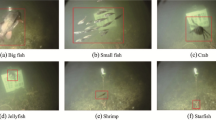Abstract
Underwater image processing is very challenging due to its environmental conditions and poor sunlight. Images captured from the ocean using autonomous vehicles are often non-uniformly illuminated and contain noise due to the underlying environment. Object recognition is a challenging task under water due to the variation in the environment, target shape and orientation. Traditional algorithms based on spatial information may not lead to accurate segmentation as the intensity variation is often less in underwater images. Texture information representing the characteristics of the object is needed. Statistical features like autocorrelation, sum average, sum variance and sum entropy were extracted. These were fed as input to learning algorithms and training was done to effectively classify the object of interest and background. Chain coding was further applied for object recognition. The proposed methodology achieved a maximum classification accuracy of 96%.












Similar content being viewed by others
References
Agrawal, S, and Xaxa DK (2014) Survey on Image Segmentation Techniques and Color Models. Int J Comput Sci Inf Technol 5(3).
Battiato S, Blanc-Talon J, Gallo G, Philips W, Popescu D, Scheunders P (2015) Advanced Concepts for Intelligent Vision Systems. Proc of 16th Int Conf, ACIVS 2015
Bengio P, Lamblin DP, Larochelle H (2007) Greedy layer-wise training of deep networks. In: Advances in neural information processing systems 19 (NIPS‘06). MIT Press, Cambridge, pp 153–160
Bezdek JC (1981) Pattern recognition with fuzzy objective function algorithms. Plenum Press, New York
Bhosle VV, Pawar VP (2013) Texture segmentation: different methods. Int J Soft Comput Eng 3(69–74)
Dunn JC (1974) A fuzzy relative of the ISODATA process and its use in detecting compact, well-separated clusters. J Cybern Inf Sci 3:32–57
Erb RJ (1993) Introduction to backpropagation neural network computation. Pharm Res 10(2):165–170
Forestli GL, Gentli S (2000) A vision based system for object detection in underwater images. Int J Pattern Recognit Artif Intell 14(2):167–188. doi:10.1142/S021800140000012X
Freeman H (1974) Computer processing of line-drawing images. ACM Comput Surv 6(1):57–97. doi:10.1145/356625.356627
Gordan M, Dancea O, Stoian I, Georgakis A, Tsatos O (2006) A new SVM-based architecture for object recognition in color underwater images with classification refinement by shape descriptors. IEEE International Conference on Automation, Quality and Testing, Robotics 2006:327–332. doi:10.1109/AQTR.2006.254654
Han, KM, Choi, HT (2011) Shape Context Based Object Recognition and Tracking in Structured Underwater Environment. IEEE International Geoscience and Remote Sensing Symposium (IGARSS), pp. 617–620. doi: 10.1109/IGARSS.2011.6049204.
Haralick RM (1973) Karthikeyan Shanmugam, and Its' Hak Dinstein, textural features for image classification. IEEE Trans Syst Man Cybern 6:610–621. doi:10.1109/TSMC.1973.4309314
Hartigan JA, Wong MA (1979) Algorithm AS 136: a K-means clustering algorithm. J R Stat Soc Ser C 28(1):100–108
Jain R, Kasturi R, Schunck BG (1995) Machine vision. McGraw Hill, New York, p 5
Joutsijoki H (2014) Et al. evaluating the performance of artificial neural networks for the classification of freshwater benthic macroinvertebrates. Eco Inform 20(1–12). doi:10.1016/j.ecoinf.2014.01.004
Jusoh NA, Mohamad J (2009) Zain, application of freeman chain codes: an alternative recognition technique for Malaysian car plates. Int J Comput Sci Netw Secur 9(11):222–227
Lloyd SP (1957) Least square quantization in PCM. IEEE Trans Inf Theory 28(2):129–137. doi:10.1109/TIT.1982.1056489
Ramadass GA, Ramesh S, Manecius Selvakumar J, Ramesh R, Subramanian AN, Sathianarayanan D, Harikrishnan G et al (2010) Deep-ocean exploration using remotely operated vehicle at gas hydrate site in Krishna-Godavari basin, Bay of Bengal. Curr Sci (00113891) 99(6):809
Ramakrishnan S, Selvan S (2007) Image texture classification using wavelet based curve fitting and probabilistic neural network. Int J Imaging Syst Technol 17(4):266–275. doi:10.1002/ima.20122
Ruspini EH (1969) A new approach to clustering. Inf Control 15:22–32
Ruspini EH (1970) Numerical methods for fuzzy clustering. Inform Sci 2:319–350
Salem A-BM, Sewisy AA, Elyan UA (2005) A vertex chain code approach for image recognition. Int J Graphics, Vision Image process 5(3):1–8
Soh L-K, Tsatsoulis C (1999) Texture analysis of SAR Sea ice imagery using gray level co-occurrence matrices. IEEE Trans Geosci Remote Sens 37(2):780–795. doi:10.1109/36.752194
Srividhya K, Ramya MM (2016) Fuzzy based adaptive contrast enhancement of underwater images.Res J Inf Technol 8:29–38
Srividhya K, Ramya MM (2017) Fuzzy-based adaptive denoising of underwater images. Int J Fuzzy Syst 1–12. doi:10.1007/s40815-016-0281-y
Tzacheva AA, Najarian K, Brockway JP (2003) Breast cancer detection in gadolinium-enhanced MR images by static region descriptors and neural networks. J Magn Reson Imaging 17(3):337–342. doi:10.1002/jmri.10259
Acknowledgements
This research work was supported by the Naval Research Board (Grant No. NRB-295/SSB/12-13), DRDO, New Delhi, India. The authors thank NIOT, Chennai, India for providing the necessary dataset. The authors would like to acknowledge Earth System science Organization NIOT (ESSO-NIOT) and Ministry of earth sciences for their support. The authors also thank Hindustan Institute of Technology and Science for their continual support.
Author information
Authors and Affiliations
Corresponding author
Rights and permissions
About this article
Cite this article
Srividhya, K., Ramya, M.M. Accurate object recognition in the underwater images using learning algorithms and texture features. Multimed Tools Appl 76, 25679–25695 (2017). https://doi.org/10.1007/s11042-017-4459-6
Received:
Revised:
Accepted:
Published:
Issue Date:
DOI: https://doi.org/10.1007/s11042-017-4459-6




